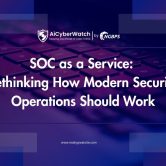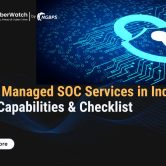Managed Detection and Response (MDR) is a proactive cybersecurity service that combines advanced threat detection, continuous monitoring, and rapid incident response. MDR providers leverage AI, machine learning, and expert analysts to identify and mitigate threats in real-time. Ideal for businesses lacking in-house security teams, MDR ensures 24/7 protection against evolving cyber threats, minimizing risk and downtime.
Below is a well-organized table summarizing the information about MDR (Managed Detection and Response) services, their use cases, economic differences, and benefits to business owners.
| Aspect | With MDR Services | Without MDR Services |
|---|---|---|
| Key Benefits | – 24/7 threat monitoring & real-time response | – Limited monitoring (often reactive) |
| – Faster detection & mitigation of threats | – Slower detection, extended response time | |
| – Access to advanced threat intelligence and global insights | – Limited or no threat intelligence | |
| – Expert incident response and containment | – In-house resources may lack expertise to respond to advanced threats | |
| – Regulatory compliance assistance (e.g., GDPR, PCI-DSS, HIPAA) | – Risk of non-compliance, potential fines | |
| Use Cases | – Limited internal security teams or small/medium businesses | – Businesses with mature internal security teams |
| – Organizations with complex IT environments (multi-cloud, hybrid) | – Companies with smaller or less complex IT infrastructures | |
| – High-risk industries (finance, healthcare, etc.) | – Organizations that can afford full in-house SOC teams | |
| – Organizations in highly regulated sectors (e.g., banks) | – Businesses without high compliance or cybersecurity threats | |
| – Companies seeking scalability for growing infrastructure | – Businesses that don’t have the budget for advanced detection tools | |
| Key Features | – 24/7 monitoring and rapid response to incidents | – Limited monitoring hours or resources |
| – Real-time threat detection with advanced tools (machine learning, AI) | – Basic detection tools, slower response times | |
| – Continuous monitoring of network, endpoints, and cloud | – Possibly no monitoring of cloud environments | |
| – Managed threat intelligence & analytics | – Reactive threat response, lacking threat intelligence | |
| Operational Impact | – Reduces internal resource burden | – Requires internal team to handle detection, response, and management |
| – Scalable service (grows with the business) | – Scaling security can be costly with internal teams | |
| – Outsourced expertise, access to advanced tools | – Relying on existing internal resources, which can be limited | |
| Cost Differences | – Monthly service fees (often lower than building in-house team) | – High internal costs for hiring and retaining security experts |
| – More affordable than creating a dedicated in-house SOC | – High costs for security tools, software, and infrastructure | |
| – Lower total cost of ownership (TCO) when compared to in-house team | – Costs increase as business grows and requires more internal resources | |
| Compliance and Risk Mitigation | – Ensures compliance with industry regulations (GDPR, PCI-DSS) | – Risk of non-compliance and regulatory fines |
| – Supports audit preparation with detailed reporting | – Difficulty in producing audit-ready reports | |
| Incident Response | – Managed detection and response by experts | – Incident response may be delayed or incomplete |
| – Rapid remediation of attacks, minimizing damage | – High potential for damage and downtime in case of breach | |
| Scalability | – Services scale with the organization’s growth | – May require additional investments as the company grows |
| – Easy to add more services, environments, and assets | – Scaling internal security operations can be resource-heavy | |
| Security Operations Center (SOC) | – Fully managed 24/7 SOC (no need for in-house team) | – Requires an in-house SOC with continuous staffing and expertise |
| – No need for additional infrastructure or staffing | – Significant overhead for SOC infrastructure |
How Business Owners Benefit from MDR Services:
| Benefit | Details |
|---|---|
| Cost Savings | – Lower operational costs compared to hiring and training an in-house SOC team. More cost-effective than investing in security infrastructure and tools. |
| Improved Security | – Real-time threat detection, faster response times, and expert mitigation reduce the chances of a data breach or cyberattack, enhancing business protection. |
| Focus on Core Business | – With MDR handling security, business owners can focus on strategic initiatives, customer growth, and core business operations without worrying about cybersecurity risks. |
| Access to Expertise | – Business owners gain access to specialized security professionals and global threat intelligence that might be expensive to hire internally. |
| Regulatory Compliance | – Ensures businesses stay compliant with industry regulations (e.g., GDPR, HIPAA), preventing costly fines and reputational damage. |
| Business Continuity | – MDR ensures quick identification and response to cyber threats, ensuring minimal business disruption and maintaining operational continuity. |
| Scalability and Flexibility | – MDR services grow with the organization, making it easier for businesses to expand without worrying about security gaps or the need to continuously upgrade security systems. |
When Should a Business Consider MDR?
| Trigger | When to Consider MDR Services |
|---|---|
| Lack of Internal Security Team | – Businesses without a dedicated SOC or security professionals should immediately consider MDR to fill the gap and ensure constant monitoring. |
| Complex IT Infrastructure | – Businesses with multi-cloud, hybrid, or complex IT environments need a comprehensive, scalable security service that MDR can provide. |
| Regulatory Requirements | – If the business operates in a regulated industry, MDR helps meet compliance requirements (e.g., PCI-DSS, HIPAA, GDPR) and avoid the risk of regulatory penalties. |
| Rising Cybersecurity Threats | – Businesses noticing an increase in cyberattacks (e.g., ransomware, phishing) or targeting of critical infrastructure should consider MDR for proactive threat detection and mitigation. |
| Lack of Expertise | – Small and medium businesses (SMBs) or those without cybersecurity expertise should use MDR to gain access to specialized skills and real-time threat detection. |
AiCyberWatch offers Managed Detection and Response (MDR) services, combining AI-driven threat detection, 24/7 monitoring, and expert-led response to combat cyber threats. Their proactive approach ensures rapid identification and mitigation of risks, safeguarding businesses from breaches. With AiCyberWatch, organizations gain enterprise-grade security without the need for an in-house SOC team. Stay protected with cutting-edge MDR solutions.
Have any queries, please visit us: https://www.aicyberwatch.com




